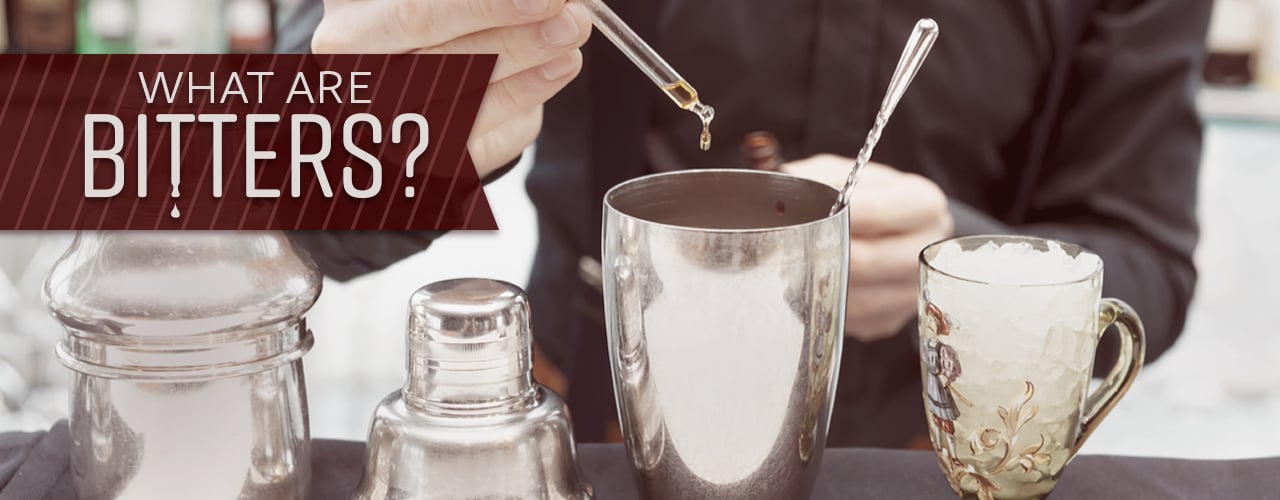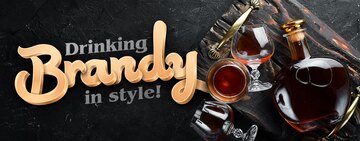Bitters are concentrated flavor extracts made by infusing herbs, spices, roots, and other botanicals in alcohol. They are mostly used to add depth and complexity to cocktails, enhancing the overall flavor profile and creating a more well-rounded drink. There are countless varieties of bitters available, with their purpose ranging from digestive aids to flavoring agents used in sauces, marinades, and dressings. Bitters play an important role in the creation of sophisticated cocktails and mocktails, making it critical that aspiring bartenders understand the different types of bitters and how to use them.
Shop All Cocktail BittersWhat Are Bitters Made Of?

While their ingredient ratios vary, bitters are made of water, alcoholic spirits, and botanicals. High-proof alcoholic spirits are ideal for making bitters. Carminative herbs, which aid digestion, are the most traditional botanicals. However, many modern bitters makers choose their botanicals for flavor alone.
What Do Bitters Taste Like?
Just like bourbon and rye are both types of whiskey but have vastly different flavor profiles, the way bitters taste depends on their ingredients and how they’re made. It’s important to note that not every cocktail with bitters has a strong bitter flavor. For example, Peychaud’s bitters taste slightly sweet with fruity notes. Bitters will enhance other flavors such as sourness or sweetness.
What Are Bitters Used For?
There are two major categories of bitters: digestive bitters and cocktail bitters. As their names suggest, digestive bitters help people digest food, and cocktail bitters are an ingredient in mixed beverages to enhance cocktail mixes.
Benefits of Bitters
Bitters are a versatile ingredient found behind the counter of most bars and nightclubs. But why are bitters considered bar essentials, and what are the benefits of bitters? We explain the top three benefits of using bitters in your cocktails.
- Bitters give your drinks complexity and depth of flavor.
- Bitters are a required ingredient for many popular cocktails.
- Just like digestive bitters, cocktail bitters are wonderful for the stomach and can aid with digestion.
What Are Digestive Bitters?
Digestive bitters, also known as digestifs, help patrons digest their meals. Digestifs are popular in Europe but lack prominence in North America. Digestive bitters are sipped straight or on the rocks and are usually served as an after-dinner drink. Aperitifs are another variety of digestives, but they’re served before meals.
Best Brand of Digestive Bitters
Some of the most famous digestive bitters brands include:
- Amaro
- Campari
- Aperol
- Jagermeister
- Unicum
Are Bitters Good For You?
Digestive bitters are a natural and effective way to support your digestive health. They can aid in digestion, relieve bloating and gas, support liver function, enhance appetite and nutrient absorption, and promote overall wellness. While digestive bitters can be a helpful addition to your wellness routine, it's important to note that they are not a magic cure-all. They work best when used in conjunction with a balanced diet, regular exercise, and other healthy lifestyle habits.
What Are Cocktail Bitters?

Cocktail bitters are a liquid flavoring agent used in alcoholic drinks. They are an essential ingredient in many staple bar drinks. Cocktail bitters are more concentrated than digestive bitters and have extraordinarily strong flavors. Subsequently, bartenders add cocktail bitters in small amounts to their drink recipes and never serve them to customers straight. They are the type of bitters most North American consumers are familiar with and are often used in mocktails.
Best Cocktail Bitters Brands
While the bitters market covers emerging brands and exotic flavors, there are three major bitters brands you should have stocked in your bar to make classic cocktails.
- Angostura Bitters
- Peychaud’s Bitters
- Regan’s Orange Bitters No. 6
What Is Angostura Bitters?
Angostura bitters are the original aromatic bitters. They are the namesake product of the oldest bitters brand, Angostura, which shaped the emerging cocktail industry when it launched in the early 1800s. Angostura bitters are a necessary ingredient for creating cocktails like the Manhattan and the Old Fashioned.
- What Do Angostura Bitters Taste Like? Angostura bitters have a spicy flavor with hints of clove and cinnamon.
- Angostura Bitters Cocktails - Old Fashioned, Manhattan, Whisky Sour, Trinidad Especial, Brooklyn’s Finest
What Is Peychaud's Bitters?
Peychaud's bitters are one of the main ingredients in a traditional Sazerac cocktail. It was created by Creole apothecary Antoine Amedee Peychaud around 1830.
- What Do Peychaud's Bitters Taste Like? Peychaud's bitters have a predominant anise and nutmeg aroma with a hint of mint that gives it a sweet flavor.
- Peychaud’s Bitters Cocktails - Sazerac, Vieux Carre, Seelbach, Cocktail A La Louisiane, Queens Park Swizzle
What Is Orange Bitters?
Orange bitters are made from the dried zest of a bitter-orange peel, like Seville oranges, and various spices. The most popular brand of orange bitters was made by mixologist Gary Regan in the 1990s.
- What Do Orange Bitters Taste Like? Orange bitters have a citrus and spice flavor from ingredients like cardamom, anise, and caraway seed.
- Orange Bitters Cocktails - Negroni, Adonis, The Opera Cocktail, The Revolver, Apple Cider Cocktails
What Is Chocolate Bitters?
Chocolate bitters are crafted by infusing cocoa nibs, cocoa beans, or chocolate extract in alcohol, along with a blend of aromatic botanicals. This process extracts the deep, earthy flavors of chocolate and creates a complex profile that can elevate your favorite cocktails to new heights.
- What Do Chocolate Bitters Taste Like? These bitters are crafted to provide a subtle hint of chocolate, rather than overpowering your taste buds with sugary sweetness.
- Chocolate Bitters Cocktails - Manhattan, Negroni, Old Fashioned
Types of Bitters

There are many types of bitters to choose from, and mixologists are constantly creating new and interesting options. We explain the main types of cocktail bitters below:
- Aromatic Bitters - Aromatic bitters are the largest and most well-known type of cocktail bitters. Companies flavor their aromatic bitters with herbs, spices, and barks, which give them powerful aromas. This is one of the oldest bitters varieties, and it’s required for many traditional cocktail recipes.
- Citrus Bitters - Citrus bitters are high-proof alcohols infused with the peels of citrus fruits. Orange bitters are the most popular type of citrus bitters. Other types of citrus bitters include lemon, grapefruit, and lime. Bartenders rely on them to make a variety of cocktail recipes.
- Herbal Bitters - Herbal bitters are one of the most varied categories of bitters in terms of flavor and aroma. Tarragon, thyme, and lavender are some of the most popular types of herbal bitters.
- Bean and Nut Bitters - Bean and nut bitters are relatively new inventions, but they are growing in popularity among adventurous bartenders and mixologists. Chocolate bitters and coffee bitters are the two most popular bean bitters varieties. Walnut, macadamia, and pecan are the most common nut bitters you'll encounter.
Making Your Own Bitters
Buying bitters may be convenient or even necessary to make certain cocktails, but you also have the option to make your own bitters. You probably already have the tools you need at your bar, so you just need to choose a base alcohol and purchase your desired botanicals. Creating your own in-house bitters allows you to fine-tune ingredient ratios and create the perfect complement to your cocktail menu.
If you make your own bitters, you can serve them in attractive bitters bottles. Using glass bottles for serving bitters helps give them an upscale aesthetic, which is ideal for modern bars and tasting rooms that want to take their drink service to the next level with professional-looking bartending supplies.
Bitters FAQs

Because of their diverse ingredients, uses, and terminology, bitters raise questions when bartenders incorporate them into their cocktails. We answer a few of the most popular bitters questions below.
How Much Is a Dash of Bitters?
A dash of bitters is usually 6-8 drops or 1/8th of a teaspoon. However, multiple factors affect how much liquid comes out with each dash, such as the size of the hole in the bottle, the angle of the bottle, the force of the shake, and how much liquid is in the bottle. If you want a precise method of adding bitters to your cocktails, use a glass bottle with a dropper.
Bitters Substitute
While you can substitute one brand of bitters for another to reimagine classic cocktails, you cannot achieve the distinct flavor complexity bitters offer with any other ingredient type. If you run out of bitters mid-shipment cycle and need a substitute for bitters, you can consider using citrus peels to mimic bitters. However, your customers will probably notice a loss of flavor quality. It’s advisable to forgo making drinks that require bitters until your next shipment arrives.
Do Bitters Go Bad?
Much like alcohol's shelf life, bitters won’t perish for many years. Bitters’s high alcohol contents act as preservatives and give them shelf lives comparable with other spirits. Most unopened bitters bottles are viable for a decade before their flavor alters. An unopened bottle of bitters will last indefinitely.
How Much Alcohol Is in Bitters?
On average, a bottle of cocktail bitters is 35-45% alcohol. However, most companies market bitters as non-alcoholic because cocktail recipes call for dashes of bitters that don’t produce a traceable ABV.
Non-Alcoholic Bitters
Non-alcoholic bitters are made using the same basic principles as their alcoholic counterparts but without the alcohol content. Although normal bitters don’t normally produce a traceable ABV due to being added in low amounts, there are still consumers who prefer their bitters to be entirely alcohol-free. Fully non-alcoholic bitters allow individuals who abstain from alcohol to still enjoy the unique flavors and sensory experience that bitters provide, making them a great option for sober bars, restaurants, and caterers looking to cater to a diverse range of customers.
History of Bitters
People have been adding bitter ingredients and flavors to alcoholic beverages since the time of the ancient Egyptians, but our modern concept of bitters emerged in the early 1800s as medicine for relieving stomach pain. Many bitters companies closed during the American Prohibition era, threatening the ingredient’s permanent loss. Thankfully, mixologists and craft cocktail makers have brought bitters back to prominence in recent years.
Bitters are a versatile and essential ingredient in the world of cocktails and continue to trend due to their use in popular mixed drinks. With their rich history, wide range of flavors, and various commercial applications, bitters offer a world of possibilities for both professional bartenders and amateur mixologists. Whether you’re looking to create a new cocktail menu or start your own sober bar, understanding the role bitters play in the drink creation process is critical to success.



